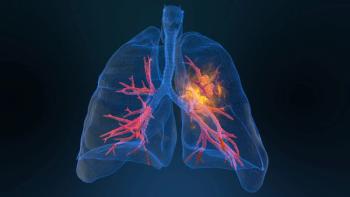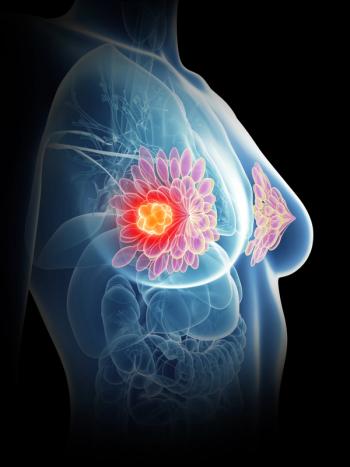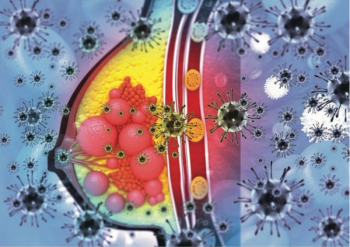
Association Found Between Occurrence of Cutaneous Immune-Related AEs and Response to Immunotherapy and Survival
Investigators reported that the development of cutaneous immune-related adverse effects has a strong association with response in survival among patients with cancer treated with immunotherapy.
The occurrence of cutaneous immune-related adverse effects (cirAEs) appears to be strongly associate with response and survival among patients with cancer who have undergone treatment with immunotherapy, according to findings from a cohort study published in JAMA Dermatology.1
Utilizing Benjamini-Hochberg (BH) correction with a significance level of .05, investigators determined that several toxicities were significantly protective of mortality. These included pruritus (hazard ratio [HR], 0.695; 95% CI, 0.602-0.803; P <.001), drug eruption (HR, 0.755; 95% CI, 0.635-0.897; P = .001), xerosis (HR, 0.626; 95% CI, 0.469-0.834; P = .001), nonspecific rashes (HR, 0.704; 95% CI, 0.634-0.781; P <.001), and appearance of any cirAE (HR, 0.778; 95% CI, 0.726-0.834; P <.001).
“These data provide oncologists and dermatologists with important prognostic information when counseling immunotherapy recipients on the clinical implications of the skin toxicities,” senior author Yevgeniy R. Semenov, MD, an investigator in the Department of Dermatology at Massachusetts General Hospital, said in a press release.2 “Also, skin toxicities tend to occur early in the course of immunotherapy and present an opportunity to evaluate efficacy soon after initiating treatment. As such, our findings may help identify patients who are more likely to benefit from their current immunotherapy regimen versus those who may need to be considered for a stronger or alternative treatment regimen.”
The retrospective cohort analysis sought to identify eligible patients via the TriNetX Diamond network, with patients being identified by Prescription for Electronic Drug Information Exchange to check for treatment with a PD-1 or PD-L1 therapy.
Investigators identified a total of 7008 patients who experienced cirAEs following treatment with PD-1 or PD-L1 inhibitor. Patients had a median survival of 1278 days within the cohort group (95% CI, 558–not reached [NR]) and 1024 days in the control group (95% CI, 455–NR).
Other significant toxicities included psoriasis (HR, 0.703; 95% CI, 0.497-0.994; P = .45) and lichen planus/lichenoid dermatitis (HR, 0.511; 95% CI, 0.279-0.939; P = .03), although they did not meet the BH correction for multiple comparisons. Additionally, investigators reported that eczematous dermatitis (HR, 0.612; 95% CI, 0.314-1.195), vitiligo (HR, 0.534; 95% CI, 0.254-1.123), bullous pemphigoid (HR, 0.524; 95% CI, 0.140-1.956), and Grover disease (HR, 0.468; 95% CI, 0.115-1.898) also appeared to be associated with strong, protective clinical effects, but did not meet statistical significance. Additional findings from the study indicated that hyperhidrosis (HR, 1.381; 95% CI, 0.961-1.985; P = .08) and mucositis (HR, 1.161; 95% CI, 0.920-1.466; P = .21) were not indicative of clinical protection.
To assess the landmark time with mortality, investigators conducted a sensitivity analysis for cirAE onset within 3 months (HR, 0.759; 95% CI, 0.703-0.818; P <.001), 9 months (HR, 0.84; 95% CI, 0.781-0.903; P <.001), and 1 year (HR, 0.829; 95% CI, 0.765-0.898; P <.001) following initiation of immunotherapy.
“To our knowledge, this is the first population-level study and largest analysis to date of the association of cirAEs with clinical outcomes among patients with advanced cancer. The results suggest that cirAE development after [immunotherapy] initiation is strongly associated with response to immune checkpoint inhibitor therapy and patient survival. With the exception of mucositis and hyperhidrosis, there was a clinically protective effect of cirAEs across all individual morphologies investigated in this study,” the study investigators concluded.
References
- Tang K, Seo J, Tiu BC, et al. Association of cutaneous immune-related adverse events with increased survival in patients treated with anti–programmed cell death 1 and anti–programmed cell death ligand 1 therapy. JAMA Dermatol. Published online January 12, 2022. doi:10.1001/jamadermatol.2021.5476
- Skin-related side effects indicate better prognosis for patients taking certain cancer drugs. News release. Massachusetts General Hospital. January 12, 2022. Accessed January 14, 2022. https://bit.ly/3flglfU
Newsletter
Stay up to date on recent advances in the multidisciplinary approach to cancer.

















































































